Unit 2 What time do you go to school?Section B (1a-2c)课件(共27张PPT,无素材)
文档属性
| 名称 | Unit 2 What time do you go to school?Section B (1a-2c)课件(共27张PPT,无素材) | 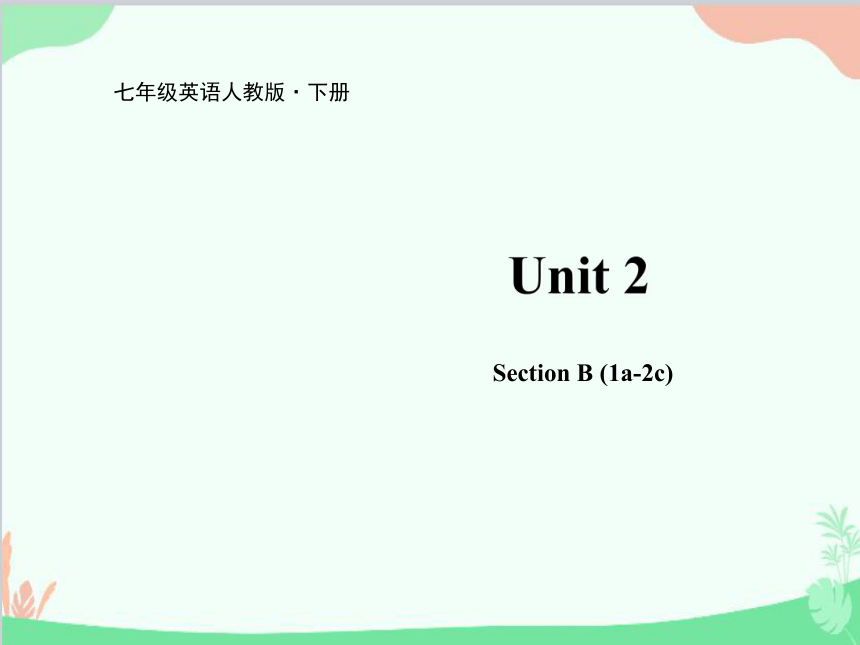 | |
| 格式 | ppt | ||
| 文件大小 | 1.5MB | ||
| 资源类型 | 教案 | ||
| 版本资源 | 人教新目标(Go for it)版 | ||
| 科目 | 英语 | ||
| 更新时间 | 2024-03-08 15:28:53 | ||
图片预览

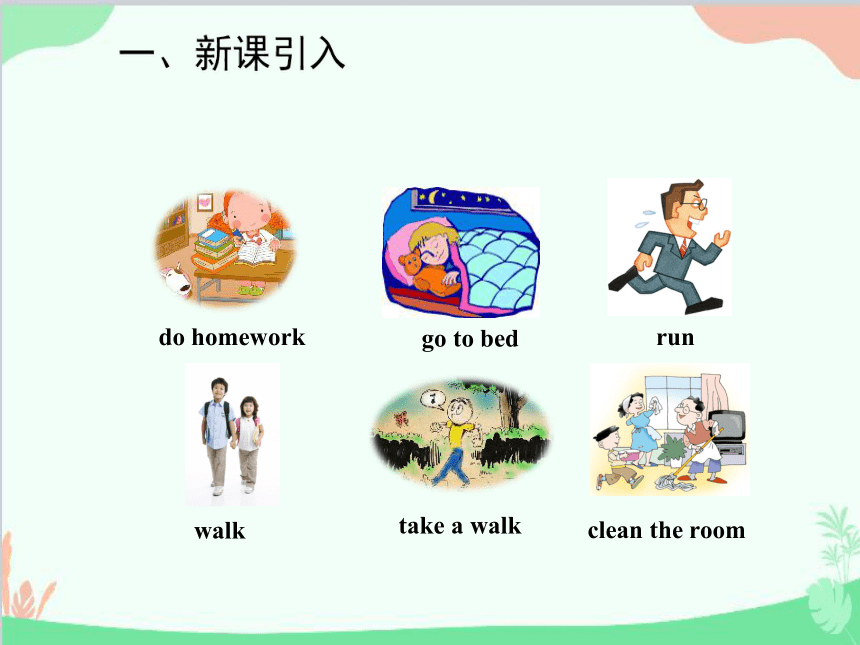
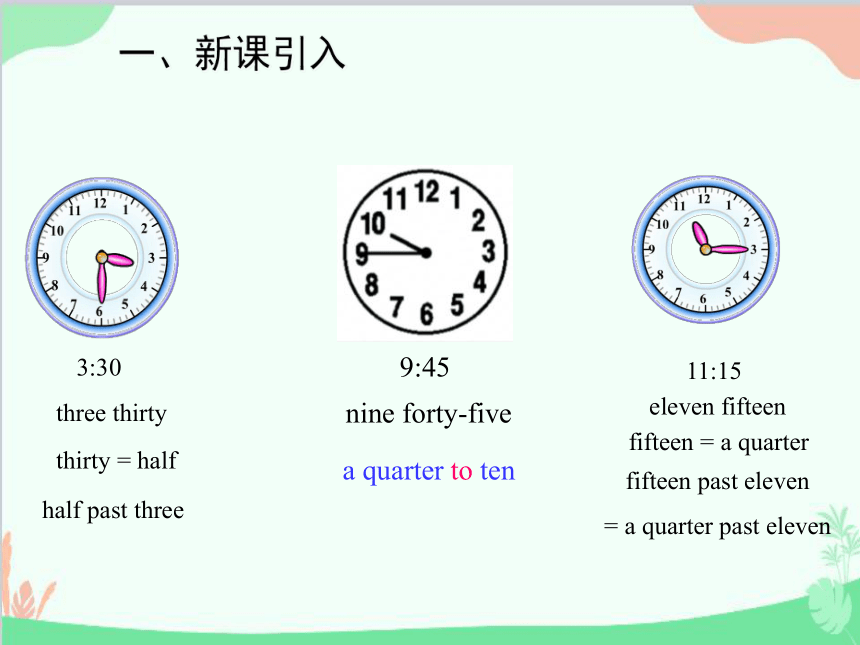
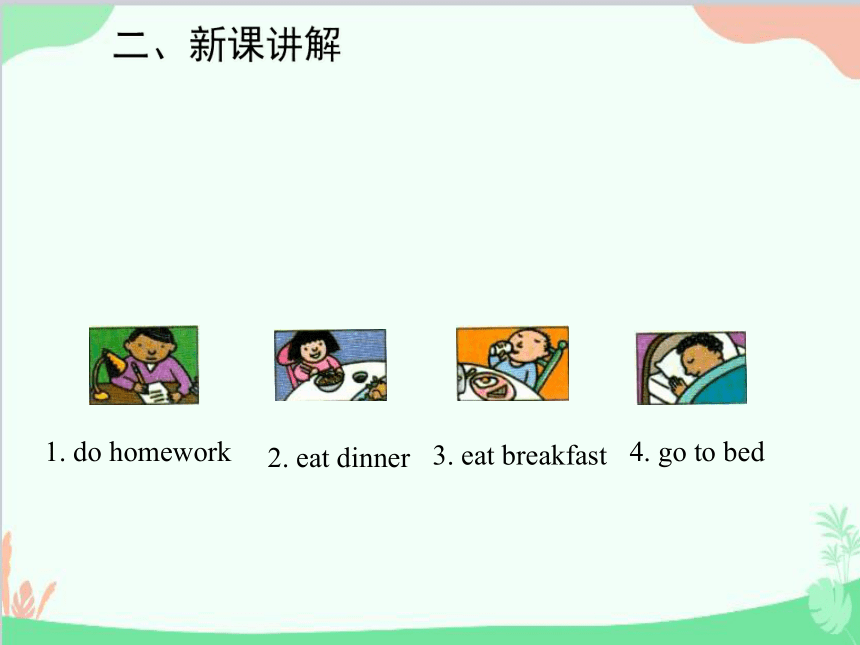
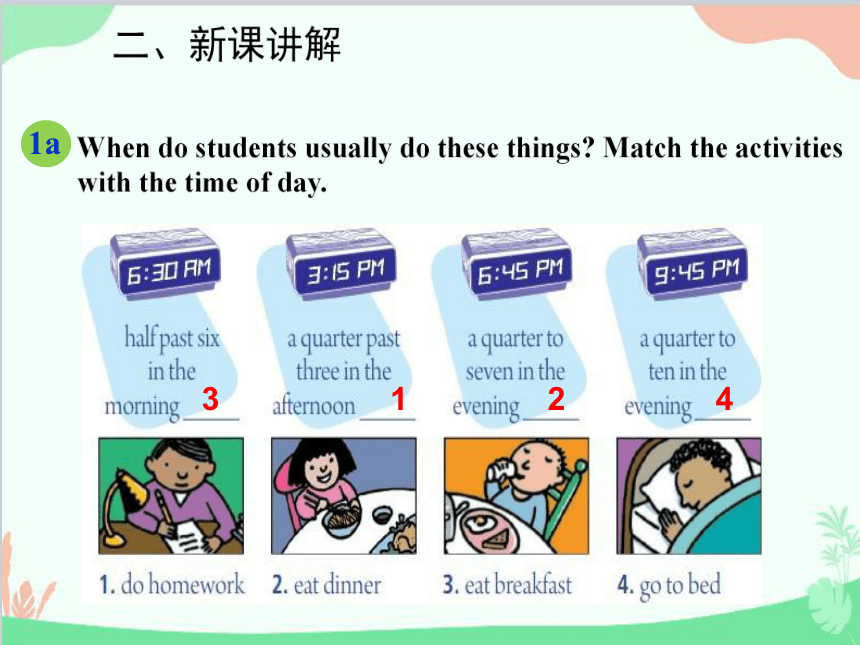
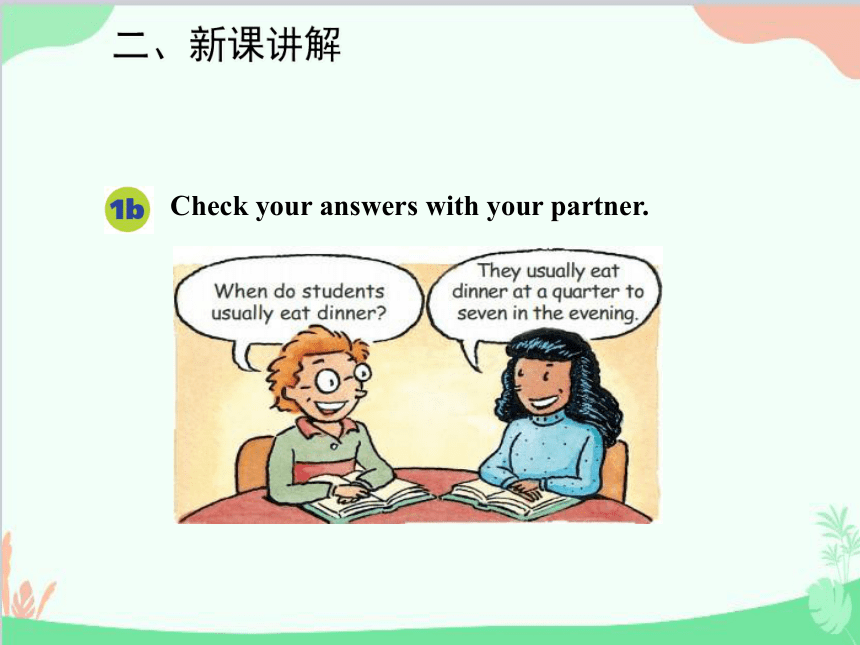
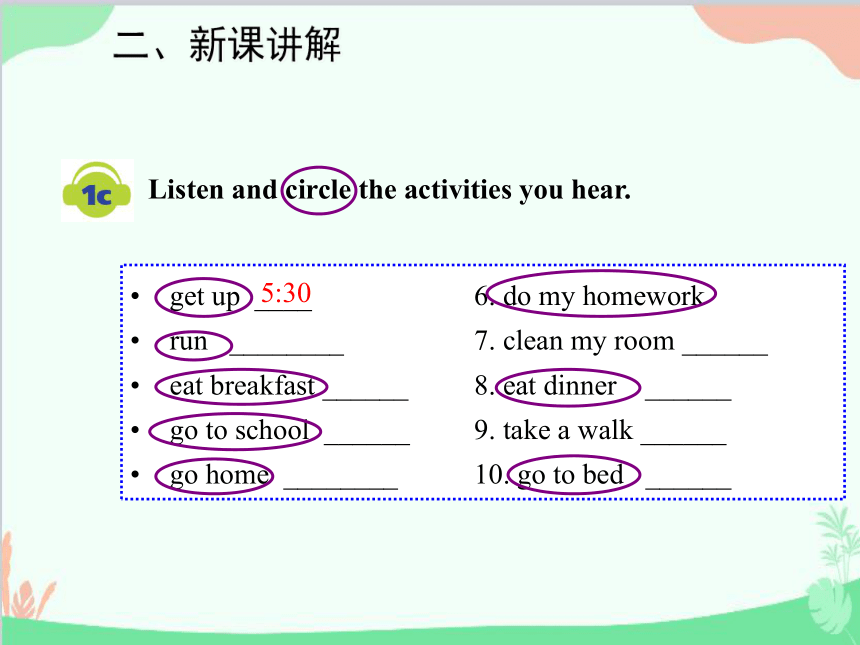

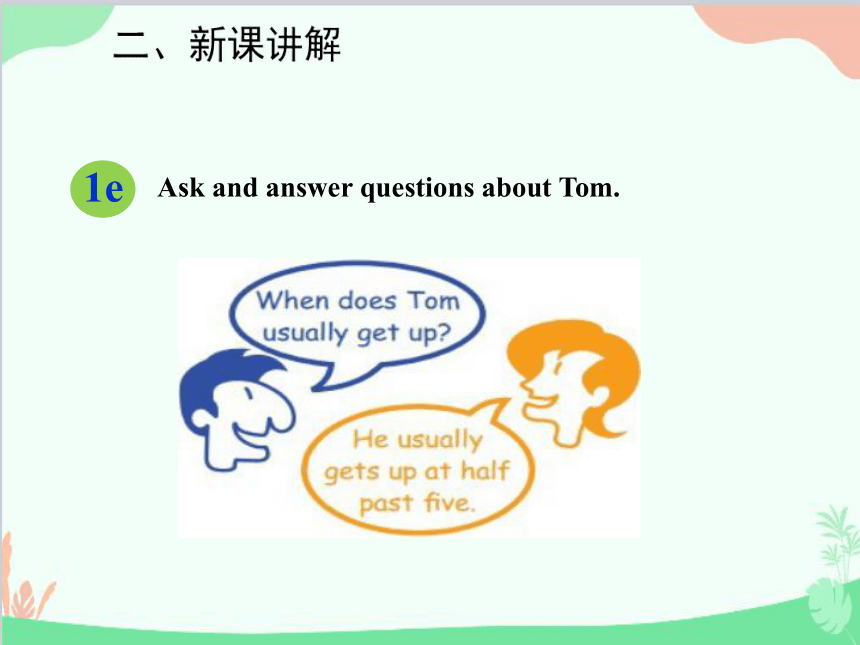
文档简介
(共27张PPT)
Unit 2
七年级英语人教版·下册
Section B (1a-2c)
一、新课引入
run
walk
go to bed
do homework
clean the room
take a walk
nine forty-five
a quarter to ten
9:45
three thirty
half past three
3:30
thirty = half
eleven fifteen
fifteen past eleven
= a quarter past eleven
11:15
fifteen = a quarter
一、新课引入
二、新课讲解
1. do homework
2. eat dinner
3. eat breakfast
4. go to bed
3
4
1
2
二、新课讲解
When do students usually do these things Match the activities
with the time of day.
1a
Check your answers with your partner.
二、新课讲解
Listen and circle the activities you hear.
get up ____ 6. do my homework
run ________ 7. clean my room ______
eat breakfast ______ 8. eat dinner ______
go to school ______ 9. take a walk ______
go home ________ 10. go to bed ______
5:30
二、新课讲解
get up ____ 6. do my homework _____
run ________ 7. clean my room ______
eat breakfast ______ 8. eat dinner ______
go to school ______ 9. take a walk ______
go home ________ 10. go to bed ______
5:30
6:00
7:00
7:45
4:15
5:30
7:15
9:00
Listen again. Write the times next to the activities you circled in 1c.
二、新课讲解
Ask and answer questions about Tom.
1e
二、新课讲解
2a
Check( √ ) the activities you think are healthy.
go to bed early_____
eat ice-cream _____
play sports_____
eat quickly_____
take a walk _____
eat vegetables _____
√
√
√
√
二、新课讲解
2b
Tony and Mary are brother and sister. They have healthy and unhealthy habits. Who is healthier Circle the healthy activities.
1. Who is healthier, Tony or Mary
2. When does Tony go to bed
3. When does Mary go to bed
Mary.
At ten thirty.
At nine thirty.
Read the passage, and answer the questions.
二、新课讲解
Read again and fill in the blanks.
Time Tony’s Activities
At eight ________
eats a quick breakfast
At eight thirty ______________
At noon ________________
After school ________________________________
__________________
In the evening
At ten thirty ______________________________
brushes teeth and goes to bed
gets up
goes to school
eats hamburgers
plays basketball for half an hour
does his homework
watches TV or plays computer games
二、新课讲解
Time Mary’s Activities
____________ gets up
takes a shower and eats a good breakfast
____________ goes to school
At twelve __________________________
After lunch __________________________
In the evening
At nine thirty _________________________________
goes to bed
At six thirty
At eight thirty
eat lots of fruit and vegetables
plays volleyball,
eats ice-cream
does her homework, swims or takes a walk
二、新课讲解
_______________________
_______________________
_______________________
_______________________
_______________________
_______________________ _______________________
2c
Write down the unhealthy habits of each person. Then think of healthy activities for them.
Unhealthy habits
_______________________
_______________________
_______________________
_______________________
_______________________
_______________________ _______________________
Healthy activities
eats breakfast fruit and vegetables
gets up early,goes to bed early
play volleyball, swim
gets up late,goes to bed late
eats breakfast quickly
eats hamburgers for lunch
Mary
Tony
二、新课讲解
play basketball
eat ice-cream
1. …so I usually eat very quickly. ······我通常吃的很快。
Language points
quickly adv. “很快地”,修饰动词、副词、形容词等。
如:The dog runs quickly. 小狗飞快地跑了。
Don’t eat quickly. It’s not a good habit. 别吃得太快。这不是个好习惯。
二、新课讲解
拓展:
quick adj. 快的;迅速的。
如:Tom eats a quick breakfast, then goes to school.
汤姆快速吃完早饭,然后就去上学了。
二、新课讲解
2. In the evening, I either watch TV or play computer games. 傍晚,我要么看电视,要么玩电脑游戏。
Language points
either… or… “或者……或者…… ” 连接两个并列名词、代词或句子成份。
如:You can either play chess or play the guitar.
你可以下棋或弹吉它。
二、新课讲解
当 either…or… 连接两个名词作主语时,谓语动词的时态和数应与最近的一个相匹配(就近一致)。
如:Either you or he is right. 不是你对就是他对。
二、新课讲解
3. …she eats lots of fruit and vegetables for lunch. ······她午餐吃很多水果蔬菜。
Language points
lots of 与 many, much 同义,都有“许多;大量”之意,但用法不同。
(1) lots of 后面可以跟可数名词也可以跟不可数名词。
如: He doesn’t have lots of (= many) books.
We have lots of (= much) work to do.
二、新课讲解
(2) many 与可数名词复数形式连用。
如:There are many apples in the basket.
篮子里有许多苹果。
(3) much 表数量时,只能修饰不可数名词。
如:We don’t have much milk.
我没有很多牛奶了。
二、新课讲解
Language points
(1) be good for … 表示“对……有益;对……有好处”;
be bad for… 表示“对……有害;对……有坏处”。
如:It’s good for our health to go to bed early and get up early.
早睡早起对我们的健康有好处。
二、新课讲解
4. She knows it’s not good for her, but it tastes good! 她知道这对她不好,但这太好吃了。
(2) taste 意为“品尝 …… 的味道”,是连系动词,后面常跟形容词。
如:Apples taste good. 苹果尝起来味道很好。
Does the ice-cream taste nice 冰淇淋尝起来味道很好吗?
拓展:taste n. “味道”。
如:The ice-cream has a taste of lemon. 这冰淇淋有点柠檬的味道。
二、新课讲解
三、归纳小结
四、强化训练
1. A: When does Jim ____________
B: He usually ____________ up at ____ ____ ____.
2. A: When do your parents _____ __ _____
B: They usually ________the room at __ ______ ____
eight in the ________.
3. A: When does Jim ____________
B: He usually ____ his _________ at __ ______ __ eight in the _______.
Complete the conversation.
get up
gets
half past six
clean the room
clean
a quarter past
morning
6:30 AM
8:15 AM
7:45 PM
do homework
does
a quarter to
evening
homework
五、布置作业
Write down five sentences about the activities you think are healthy and unhealthy.
谢谢大家!
Unit 2
七年级英语人教版·下册
Section B (1a-2c)
一、新课引入
run
walk
go to bed
do homework
clean the room
take a walk
nine forty-five
a quarter to ten
9:45
three thirty
half past three
3:30
thirty = half
eleven fifteen
fifteen past eleven
= a quarter past eleven
11:15
fifteen = a quarter
一、新课引入
二、新课讲解
1. do homework
2. eat dinner
3. eat breakfast
4. go to bed
3
4
1
2
二、新课讲解
When do students usually do these things Match the activities
with the time of day.
1a
Check your answers with your partner.
二、新课讲解
Listen and circle the activities you hear.
get up ____ 6. do my homework
run ________ 7. clean my room ______
eat breakfast ______ 8. eat dinner ______
go to school ______ 9. take a walk ______
go home ________ 10. go to bed ______
5:30
二、新课讲解
get up ____ 6. do my homework _____
run ________ 7. clean my room ______
eat breakfast ______ 8. eat dinner ______
go to school ______ 9. take a walk ______
go home ________ 10. go to bed ______
5:30
6:00
7:00
7:45
4:15
5:30
7:15
9:00
Listen again. Write the times next to the activities you circled in 1c.
二、新课讲解
Ask and answer questions about Tom.
1e
二、新课讲解
2a
Check( √ ) the activities you think are healthy.
go to bed early_____
eat ice-cream _____
play sports_____
eat quickly_____
take a walk _____
eat vegetables _____
√
√
√
√
二、新课讲解
2b
Tony and Mary are brother and sister. They have healthy and unhealthy habits. Who is healthier Circle the healthy activities.
1. Who is healthier, Tony or Mary
2. When does Tony go to bed
3. When does Mary go to bed
Mary.
At ten thirty.
At nine thirty.
Read the passage, and answer the questions.
二、新课讲解
Read again and fill in the blanks.
Time Tony’s Activities
At eight ________
eats a quick breakfast
At eight thirty ______________
At noon ________________
After school ________________________________
__________________
In the evening
At ten thirty ______________________________
brushes teeth and goes to bed
gets up
goes to school
eats hamburgers
plays basketball for half an hour
does his homework
watches TV or plays computer games
二、新课讲解
Time Mary’s Activities
____________ gets up
takes a shower and eats a good breakfast
____________ goes to school
At twelve __________________________
After lunch __________________________
In the evening
At nine thirty _________________________________
goes to bed
At six thirty
At eight thirty
eat lots of fruit and vegetables
plays volleyball,
eats ice-cream
does her homework, swims or takes a walk
二、新课讲解
_______________________
_______________________
_______________________
_______________________
_______________________
_______________________ _______________________
2c
Write down the unhealthy habits of each person. Then think of healthy activities for them.
Unhealthy habits
_______________________
_______________________
_______________________
_______________________
_______________________
_______________________ _______________________
Healthy activities
eats breakfast fruit and vegetables
gets up early,goes to bed early
play volleyball, swim
gets up late,goes to bed late
eats breakfast quickly
eats hamburgers for lunch
Mary
Tony
二、新课讲解
play basketball
eat ice-cream
1. …so I usually eat very quickly. ······我通常吃的很快。
Language points
quickly adv. “很快地”,修饰动词、副词、形容词等。
如:The dog runs quickly. 小狗飞快地跑了。
Don’t eat quickly. It’s not a good habit. 别吃得太快。这不是个好习惯。
二、新课讲解
拓展:
quick adj. 快的;迅速的。
如:Tom eats a quick breakfast, then goes to school.
汤姆快速吃完早饭,然后就去上学了。
二、新课讲解
2. In the evening, I either watch TV or play computer games. 傍晚,我要么看电视,要么玩电脑游戏。
Language points
either… or… “或者……或者…… ” 连接两个并列名词、代词或句子成份。
如:You can either play chess or play the guitar.
你可以下棋或弹吉它。
二、新课讲解
当 either…or… 连接两个名词作主语时,谓语动词的时态和数应与最近的一个相匹配(就近一致)。
如:Either you or he is right. 不是你对就是他对。
二、新课讲解
3. …she eats lots of fruit and vegetables for lunch. ······她午餐吃很多水果蔬菜。
Language points
lots of 与 many, much 同义,都有“许多;大量”之意,但用法不同。
(1) lots of 后面可以跟可数名词也可以跟不可数名词。
如: He doesn’t have lots of (= many) books.
We have lots of (= much) work to do.
二、新课讲解
(2) many 与可数名词复数形式连用。
如:There are many apples in the basket.
篮子里有许多苹果。
(3) much 表数量时,只能修饰不可数名词。
如:We don’t have much milk.
我没有很多牛奶了。
二、新课讲解
Language points
(1) be good for … 表示“对……有益;对……有好处”;
be bad for… 表示“对……有害;对……有坏处”。
如:It’s good for our health to go to bed early and get up early.
早睡早起对我们的健康有好处。
二、新课讲解
4. She knows it’s not good for her, but it tastes good! 她知道这对她不好,但这太好吃了。
(2) taste 意为“品尝 …… 的味道”,是连系动词,后面常跟形容词。
如:Apples taste good. 苹果尝起来味道很好。
Does the ice-cream taste nice 冰淇淋尝起来味道很好吗?
拓展:taste n. “味道”。
如:The ice-cream has a taste of lemon. 这冰淇淋有点柠檬的味道。
二、新课讲解
三、归纳小结
四、强化训练
1. A: When does Jim ____________
B: He usually ____________ up at ____ ____ ____.
2. A: When do your parents _____ __ _____
B: They usually ________the room at __ ______ ____
eight in the ________.
3. A: When does Jim ____________
B: He usually ____ his _________ at __ ______ __ eight in the _______.
Complete the conversation.
get up
gets
half past six
clean the room
clean
a quarter past
morning
6:30 AM
8:15 AM
7:45 PM
do homework
does
a quarter to
evening
homework
五、布置作业
Write down five sentences about the activities you think are healthy and unhealthy.
谢谢大家!
同课章节目录
- Unit 1 Can you play the guitar?
- Section A
- Section B
- Unit 2 What time do you go to school?
- Section A
- Section B
- Unit 3 How do you get to school?
- Section A
- Section B
- Unit 4 Don't eat in class.
- Section A
- Section B
- Unit 5 Why do you like pandas?
- Section A
- Section B
- Unit 6 I'm watching TV.
- Section A
- Section B
- Review of Units 1-6
- Unit 7 It's raining!
- Section A
- Section B
- Unit 8 Is there a post office near here?
- Section A
- Section B
- Unit 9 What does he look like?
- Section A
- Section B
- Unit 10 I'd like some noodles.
- Section A
- Section B
- Unit 11 How was your school trip?
- Section A
- Section B
- Unit 12 What did you do last weekend?
- Section A
- Section B
